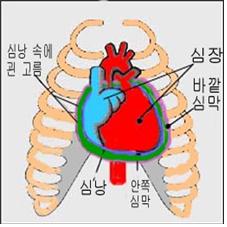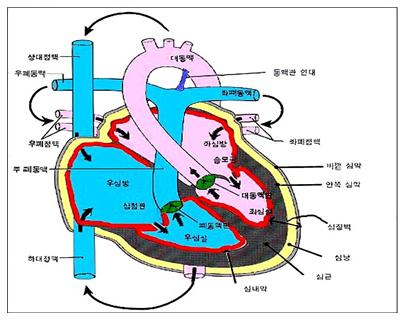심낭염 Pericarditis

그림 96. 심낭염
Copyright ⓒ 2013 John Sangwon Lee, MD., FAAP

그림 95. 심장과 심장벽
화살표(→)는 혈액이 흐르는 방향
검은 색으로 표시된 부위가 심장 근육(심근)
소스; Used with permission from Ross Laboratories Columbus, OH, USA
-
심장의 맨 바깥 심장 벽을 둘러싼 얇은 두 겹의 막을 심막이라고 한다.
-
심막에는 안쪽 심막과 바깥쪽 심막 모두 두 겹이 있다.
-
이 두 겹의 심막의 사이에 있는 공간을 심낭이라고 한다.
-
소량의 맑은 체액이 정상적으로 심낭 속에 들어 있다.
-
심낭 속에 감염이 생기거나 다른 원인으로 짙은 고름이나 피고름 또는 맑은 체액 등이 심낭 속에 괴어있고 거기에 염증이 생기면 심낭염이라고 한다.
심낭염의 원인
-
결핵균, 황색 포도상구균, B형 헤모필러스 인플루엔자균, 그 밖에 다른 여러 종류의 박테리아 등 병원체 감염으로 심낭염이 생길 수 있다.
-
콕삭키바이러스 감염과 그 외 다른 종류의 바이러스 감염 등으로 바이러스성 심낭염이 생길 수 있다.
-
류마티스 심장염, 심장 부전증, 심장 수술, 암, 백혈병, 류마토이드 관절염(연소성 류마토이드 관절염), 요독증, 류마티스 열, 그 외 다른 여러 가지 질병으로도 심낭 속에 체액이 괴여 심낭염이 생길 수 있다.
심낭염의 증상 징후
-
일반적으로 심낭 속에 괸 고름이나 체액의 양, 고름이나 체액이 괴는 속도, 심낭염을 일으킨 병원체나 병의 종류에 따라 증상 징후가 다르다.
-
심낭염이 있어도 심낭염의 증상 징후가 하나도 없는 경우도 있고, 아주 짧은 기간 내 심낭 속에 고름이나 물이 많이 차서 사망할 수 있다.
-
심낭 속에 체액이나 고름이 많이 찰 때는 심장의 수축과 심장의 이완이 정상적으로 잘 될 수 없어 심장이 온몸에서 돌아온 정맥혈을 폐 속으로 제대로 펌프 할 수 없고, 또 양쪽 폐에서 돌아온 동맥혈을 대동맥을 통해 전신으로 제대로 펌프 해 보낼 수가 없다.
-
이런 이유 때문에 폐 속에 피가 많이 괴게 되고, 숨을 가쁘게 쉬고, 그 외로 다른 여러 증상 징후가 생길 수 있다.
-
심낭염으로 생긴 증상 징후와 심낭염을 일으킨 병원체 감염에 의해서 생긴 전염병의 증상 징후가 동시에 생길 수 있다.
-
보통 심낭염이 있을 때는 왼쪽 앞가슴이나 왼쪽 어깨나 또는 그 쪽 목이 아플 수 있다. 심낭염이 심할 땐 전신에 부종이 생길 수 있다.
심낭염의 진단
-
병력, 증상 징후와 진찰소견 등을 종합해서 이 병이 있다고 의심되면 심전도 검사, 가슴 X-선 사진 검사, 심장 초음파 검사, 심도자법 검사와 그 외 다른 적절한 검사로 진단한다.
심낭염의 치료
-
심낭염을 일으킨 원인, 증상 징후에 따라서 치료한다.
-
병원에 입원 치료하는 것이 보통이다.
Pericarditis 심낭염

Figure 96. Pericarditis Copyright ⓒ 2013 John Sangwon Lee, MD., FAAP

Figure 95. Heart and heart wall Arrow (→) is the direction in which blood flows The area marked in black is the heart muscle (myocardium) sauce; Used with permission from Ross Laboratories Columbus, OH, USA
• The outermost layer of the heart that surrounds the heart wall is called the pericardium.
• The pericardium has two layers, both the inner and outer pericardium.
• The space between these two layers of pericardium is called the pericardium.
• A small amount of clear fluid is normally contained in the pericardium.
• If an infection occurs in the pericardium or other causes, such as dense pus, blood pus, or clear body fluid, are confined in the pericardium and become inflamed, it is called pericarditis.
Causes of pericarditis
• Infection with pathogens such as Mycobacterium tuberculosis, Staphylococcus aureus, Haemophilus influenzae B, and many other types of bacteria can lead to pericarditis.
• Viral pericarditis can result from infection with Coxsackie virus and other types of viral infections.
• Rheumatoid carditis, heart failure, heart surgery, cancer, leukemia, rheumatoid arthritis (combustible rheumatoid arthritis), uremia, rheumatic fever, and many other diseases can cause pericarditis due to fluid buildup in the pericardium.
Symptoms signs of pericarditis
• In general, symptoms of symptoms differ depending on the amount of pus or fluid in the pericardium, the rate at which the pus or fluid is formed, and the type of pathogen or disease that caused pericarditis.
• Even with pericarditis, there are no signs of pericarditis, and in a very short period of time, a lot of pus or water in the pericardium can cause death.
• When there is a lot of fluid or pus in the pericardium, the contraction of the heart and relaxation of the heart cannot be performed normally, so the heart cannot properly pump the venous blood returned from the whole body into the lungs. I can’t pump it properly.
• For this reason, there may be a lot of bleeding in the lungs, short breathing, and other signs of symptoms.
• Symptoms of pericarditis and symptoms of an infectious disease caused by infection with the pathogen that caused pericarditis may occur at the same time.
• Usually with pericarditis, the left anterior chest, left shoulder, or neck may hurt. When pericarditis is severe, swelling can occur throughout the body.
Diagnosis of pericarditis
• If you suspect that you have this disease by combining your medical history, symptoms, signs, and examination findings, you should diagnose it with an electrocardiogram, chest x-ray, echocardiography, cardiography, and other appropriate tests. Treatment of pericarditis
• Treat according to the cause of the pericarditis and the symptoms and symptoms. • Inpatient treatment in a hospital is common.
출처 및 참조 문헌 Sources and references
- NelsonTextbook of Pediatrics 22ND Ed
- The Harriet Lane Handbook 22ND Ed
- Growth and development of the children
- Red Book 32nd Ed 2021-2024
- Neonatal Resuscitation, American Academy Pediatrics
- www.drleepediatrics.com제11권. 소아청소년 심장 혈관계 질환
- www.drleepediatrics.com제7권 소아청소년 감염병
- Red book 29th-31st edition 2021
- Nelson Text Book of Pediatrics 19th — 21st Edition
- The Johns Hopkins Hospital, The Harriet Lane Handbook, 22nd edition
-
Childhood Emergencies in the Office, Hospital and Community, American Academy of Pediatrics
-
Emergency Medical Service for Children, By Ross Lab. May 1989. p.10
-
Emergency care, Harvey grant, and Robert Murray
-
Emergency Care Transportation of Sick and Injured American Academy of Orthopaedic Surgeons
-
Emergency Pediatrics A Guide to Ambulatory Care, Roger M. Barkin, Peter Rosen
-
Immediate care of the acutely ill and injured, Hugh E. Stephenson, Jr
-
The Critically Ill Child, Diagnosis and Management, Edited by Clement A. Smith
-
Emergency Medical Services for Children: The Role of the Primary Care Provider, America Academy of Pediatrics
-
Quick Reference To Pediatric Emergencies, Delmer J. Pascoe, M.D., Moses Grossman, M.D. with 26 contributors
-
Manual of Emergency Care
-
응급환자관리 정담미디어
-
소아가정간호백과–부모도 반의사가 되어야 한다, 이상원
-
Neonatal Resuscitation American heart Association
-
Neonatology Jeffrey J.Pomerance, C. Joan Richardson
-
Pediatric Resuscitation Pediatric Clinics of North America, Stephen M. Schexnayder, M.D.
-
Pediatric Critical Care, Pediatric Clinics of North America, James P. Orlowski, M.D.
-
Preparation for Birth. Beverly Savage and Dianna Smith
- Infectious disease of children, Saul Krugman, Samuel L Katz, Ann A. Gershon, Catherine Wilfert
-
The Harriet Lane Handbook 19th Edition
-
소아과학 대한교과서
-
제1권 소아청소년 응급의료 참조문헌과 출처
-
Other
Copyright ⓒ 2015 John Sangwon Lee, MD., FAAP
“부모도 반의사가 되어야 한다”-내용은 여러분들의 의사로부터 얻은 정보와 진료를 대신할 수 없습니다.
“The information contained in this publication should not be used as a substitute for the medical care and advice of your doctor. There may be variations in treatment that your doctor may recommend based on individual facts and circumstances. “Parental education is the best medicine.”